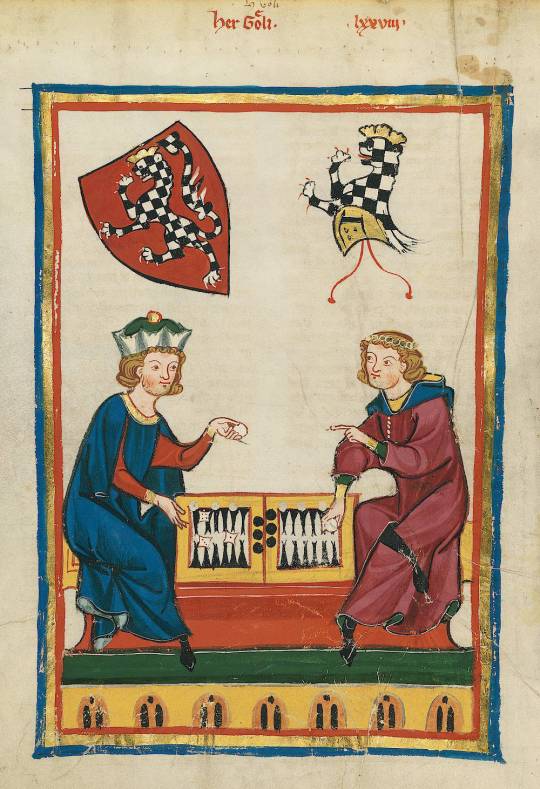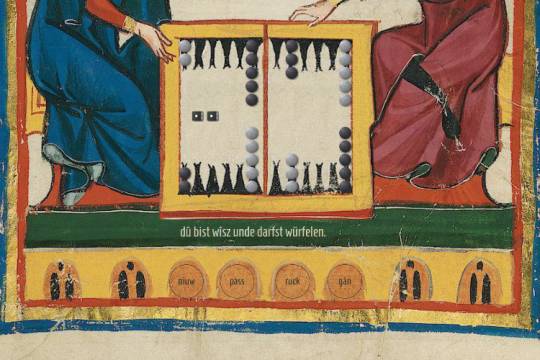Challenge view
Back to ProjectManesse Gammon
A medieval game: Play against «Herrn Gœli»
The Codex Manesse, or «Große Heidelberger Liederhandschrift», is an outstanding source of Middle High German Minnesang, a book of songs and poetry the main body of which was written and illustrated between 1250 and 1300 in Zürich, Switzerland. The Codex, produced for the Manesse family, is one of the most beautifully illustrated German manuscripts in history.
The Codex Manesse is an anthology of the works of about 135 Minnesingers of the mid 12th to early 14th century. For each poet, a portrait is shown, followed by the text of their works. The entries are ordered by the social status of the poets, starting with the Holy Roman Emperor Heinrich VI, the kings Konrad IV and Wenzeslaus II, down through dukes, counts and knights, to the commoners.
Page 262v, entitled «Herr Gœli», is named after a member of the Golin family originating from Badenweiler, Germany. «Herr Gœli» may have been identified either as Konrad Golin (or his nephew Diethelm) who were high ranked clergymen in 13th century Basel. The illustration, which is followed by four songs, shows «Herrn Gœli» and a friend playing a game of Backgammon (at that time referred to as «Pasch», «Puff», «Tricktrack», or «Wurfzabel»). The game is in full swing, and the players argue about a specific move.
Join in and start playing a game of backgammon against «Herrn Gœli». But watch out: «Herr Gœli» speaks Middle High German, and despite his respectable age he is quite lucky with the dice!
Instructions
You control the white stones. The object of the game is to move all your pieces from the top-left corner of the board clockwise to the bottom-left corner and then off the board, while your opponent does the same in the opposite direction. Click on the dice to roll, click on a stone to select it, and again on a game space to move it. Each die result tells you how far you can move one piece, so if you roll a five and a three, you can move one piece five spaces, and another three spaces. Or, you can move the same piece three, then five spaces (or vice versa). Rolling doubles allows you to make four moves instead of two.
Note that you can't move to spaces occupied by two or more of your opponent's pieces, and a single piece without at least another ally is vulnerable to being captured. Therefore it's important to try to keep two or more of your pieces on a space at any time. The strategy comes from attempting to block or capture your opponent's pieces while advancing your own quickly enough to clear the board first.
And don't worry if you don't understand what «Herr Gœli» ist telling you in Middle High German: Point your mouse to his message to get a translation into modern English.
Updates
- 2016/07/01 v1.0: Index page, basic game engine
- 2016/07/02 v1.1: Translation into Middle High German, responsive design
- 2016/07/04 v1.11: Minor bug fixes
Data
- Universitätsbibliothek Heidelberg: Der Codex Manesse und die Entdeckung der Liebe
- Universitätsbibliothek Heidelberg: Große Heidelberger Liederhandschrift -- Cod. Pal. germ. 848 (Codex Manesse)
- Wikimedia Commons: Codex Manesse
- Historisches Lexikon der Schweiz: Manessische Handschrift
- Historisches Lexikon der Schweiz: Baden, von
- Wörterbuchnetz: Mittelhochdeutsches Handwörterbuch von Matthias Lexer
Author
- Prof. Thomas Weibel, Thomas Weibel Multi & Media


